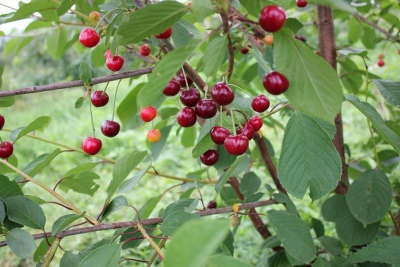
- Authors: Astakhov A.I., Kanshina M.V., Astakhov A.A.
- Year of approval: 2004
- Barrel type: wood
- Growth type: medium-sized
- Crown: sprawling, spherical
- Leaves: medium, wide, obovate, green, smooth
- Flowers: small, saucer-shaped corolla, free-flowing petals, white
- Flowering and fruiting type: on a one-year increment
- Fruit size: average
- Fruit size, mm: 19x21x19
Cherries are now represented by a large number of varieties. But even against this general background, Igritskaya can be a good solution. You just need to carefully study its features and correctly apply the plant.
Breeding history
The culture was allowed to be used in Russia in 2004. The breeders of Kanshina and Astakhovs worked on its breeding. The variety is officially listed in the crop register. The project was implemented at the VNII Lupina. After being put into circulation, the plant has already received wide recognition in our country.
Description of the variety
Igritskaya is one of the common cherries with a universal purpose. Medium-sized trees are crowned with a spreading spherical crown. The branches droop noticeably. The green leaves are medium in size and look like an inverted egg. The flowers do not reach a large size, are painted white, differ in the free arrangement of petals and are grouped into inflorescences of 3 pieces.
Fruit characteristics
Cherries of this sort are characterized by a range of weight from 4.1 to 5.2 g. In most cases, they are of average size. Other features are as follows:
- flat-round geometric shape;
- dark red color of the surface;
- red color of juice;
- ease of separation from the branch;
- ease of separation of the bone.
Taste qualities
The dark red flesh has a sweet and sour taste. It is always juicy. The Igritskaya cherry fruits show moderate firmness. The share of sugars reaches 9.5%, but acids - only 0.9%. The tasting examination gave the crops an assessment of 4.6 points.
Ripening and fruiting
Fruits will appear on annual growths. The first of them can be seen in the 5th year of development. Cherries ripen late. At the same time, they will ripen at the same time.

Yield
On average, the productivity of the variety is 43 centners per 1 ha (according to other sources - 41.5 centners). At the same time, the highest recorded level reaches 87 centners. Important: plants are relatively resistant to even harsh winters. According to some sources, the harvest from 1 tree can reach 8 kg. The harvested fruits are easily transported over a long distance and stored without any problems.
Growing regions
The culture is officially zoned in Central Russia (climatic zone 3). Growing in all other areas is at your own peril and risk.
Self-fertility and the need for pollinators
Partial self-fertility is noted in the official description. Therefore, without the help of additional plants, one can only count on a meager harvest. Any other cherry with close flowering dates is a suitable candidate. Among them, the most optimal varieties are Lyubskaya and Zhuravka.
Landing
Igritskaya cherry is unpretentious, but it is still better to choose a sunny place for it, closed from the chilly winds.It is unwise to plant such a crop in the lowlands where moisture collects. Any wetlands should also be avoided. The depth of the planting hole should be approximately 0.7-0.8 m. Its optimum width is 0.5-0.6 m.
The soil for filling the hole is prepared additionally. Humus and complex mineral compositions are added to the excavated earth. Additionally, you will need to add a small amount of washed river sand. Be sure to drive in a stake. When planting, the roots are leveled, straightened and covered with soil as carefully as possible so as not to damage anything; the procedure ends with tamping the earth and watering the hole.


Growing and care
Cherry Igritskaya is suitable for areas with both warm and unstable climatic conditions. However, in the latter case, it is important to prepare for work as clearly as possible and strictly follow the basic norms of agricultural technology. For the first time after planting, the culture is watered weekly. Then reduce the frequency of watering by half, while they should be abundant. It is necessary to activate irrigation only in extreme heat.
Crown shaping should be done annually. Rejuvenating pruning is also required. At one time, no more than a third of each skeletal branch is removed. Top dressing in the first year of development will not be required. Then fertilizers are applied during flowering, during fruiting and in preparation for winter.


Disease and pest resistance
The risk of fruit cracking is low. At the same time, there is almost complete protection from fungal infections, from moniliosis and coccomycosis. Preventive treatments are carried out in early spring. After the beginning of flowering, synthetic and other potent agents cannot be used.
































































